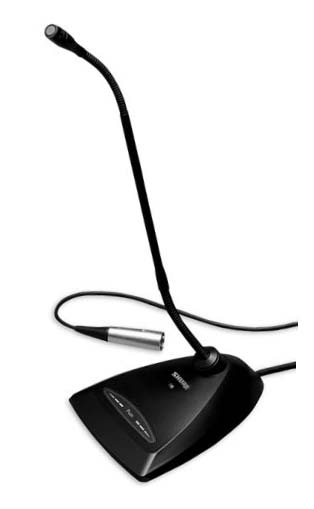In order to select a microphone for a specific application, and to apply it properly, it’s first necessary to know the important characteristics of the sound source(s) and of the sound system.
Once these are defined, a look at the five areas of microphone specifications will lead to an appropriate match. Finally, proper use of the microphone, by correct placement and operation, will insure best performance.
Following are recommendations for some of the most common meeting facility sound applications.
Lectern
The desired sound source, for a lectern microphone, is a speaking voice. Undesired sound sources that may be present are nearby loudspeakers (possibly overhead) and ambient sound (possibly ventilation, traffic noise, and reverberation).
The sound system in this and the following examples is assumed to be high quality with balanced low-impedance microphone inputs.
The basic performance requirements for a lectern microphone can be met by either dynamic or condenser types, so the choice of operating principle is often determined by other factors, such as appearance.
In particular, the desire for an unobtrusive microphone is best satisfied by a condenser microphone, which can maintain high performance even in very small sizes. If phantom power is available, a condenser is an excellent choice. If not, dynamic types, though somewhat larger, are available with similar characteristics.
For the microphone to match the desired sound source (the talker’s voice) it must first have a frequency response which covers the speech range, (approximately 100Hz to 10kHz).
Within that range the response can be flat, if the sound system and the room acoustics are very good, but often a shaped response will improve intelligibility. Above 10 kHz and below 100 Hz, the response should roll off smoothly, to avoid pickup of noise and other sounds outside of the speech range, and to minimize proximity effect.
The choice of microphone directionality that will maximize pickup of the voice and minimize undesired sounds, is unidirectional. This type will also reduce the potential of feedback since it can be aimed toward the talker and away from loudspeakers.
Depending on how much the person speaking moves about, or on how close the microphone can be placed, a particular type may be chosen: a cardioid for moderately broad, close-up coverage; a supercardioid or a hypercardioid for progressively narrower or more distant coverage.
The electrical characteristics of the microphone are primarily determined by the sound system: in this case, a balanced low – impedance type would match the inputs on the mixer.
Of course, this would be the desired choice in almost all systems due to the inherent benefits of lower noise and longer cable capability.
















